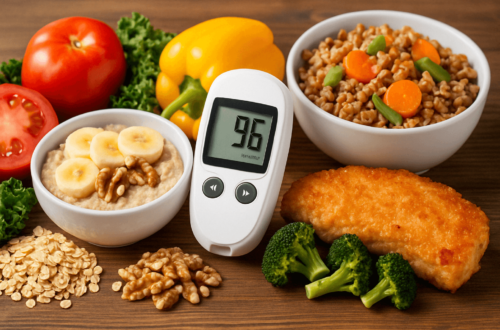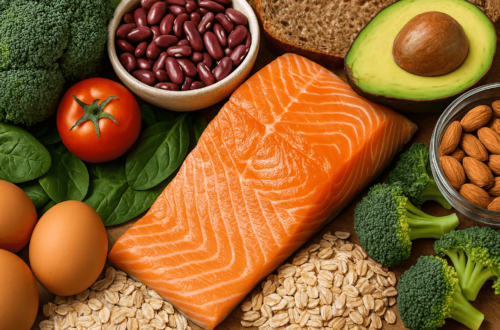
How to Create a Balanced Diabetic Meal Plan for Seniors: Tips & Tricks
As we age, our nutritional needs evolve, and for seniors managing diabetes, making the right food choices becomes even more critical. A well-balanced diabetic meal plan not only helps control blood sugar but also supports overall health and well-being. By focusing on nutrient-dense ingredients and easy-to-cook recipes, seniors can manage their diabetes effectively while enjoying delicious meals.
In this article, we’ll provide actionable tips and tricks for building a balanced diabetic meal plan for seniors, ensuring that meals are both healthy and easy to prepare. We’ll also highlight how the “Diabetic Diet After 50” cookbook provides a variety of meal plans and recipes designed specifically for blood sugar control.
The Importance of a Balanced Diabetic Meal Plan for Seniors
A balanced meal plan for seniors with diabetes should aim to:
- Maintain stable blood sugar levels: This is key to avoiding spikes and crashes in blood sugar, which can be harmful over time.
- Support overall health: Diabetes is often associated with other age-related health issues like heart disease, kidney problems, and weight management. A nutritious meal plan can help manage these conditions.
- Promote weight control: Managing a healthy weight can help improve insulin sensitivity and make it easier to control blood sugar levels.
- Boost energy and maintain muscle mass: Proper nutrition helps maintain energy levels and muscle mass, both of which tend to decrease with age.
Key Principles for Creating a Balanced Diabetic Meal Plan
When creating a meal plan for seniors with diabetes, it’s essential to focus on the following principles:
1. Carbohydrate Control
Carbohydrates have the most significant impact on blood sugar, so it’s essential to choose the right type of carbs and control portion sizes. For seniors with diabetes, low glycemic index (GI) foods are ideal as they release glucose slowly and help maintain stable blood sugar levels.
- Include high-fiber carbs: Fiber-rich foods like whole grains (brown rice, quinoa), legumes (lentils, beans), and vegetables help regulate blood sugar levels and improve digestion.
- Limit refined carbs and sugary foods: Avoid foods like white bread, pastries, sugary snacks, and sodas, as they cause rapid spikes in blood sugar.
2. Lean Proteins for Blood Sugar Control
Protein is an essential macronutrient that helps stabilize blood sugar and supports muscle health. Choose lean sources of protein to minimize unhealthy fats.
- Ideal protein choices: Skinless poultry, fish (especially fatty fish like salmon), tofu, and legumes are all excellent protein sources.
- Balancing protein and carbs: Aim to include a lean protein source with every meal to help slow the absorption of carbohydrates and maintain blood sugar control.
3. Healthy Fats for Heart and Brain Health
Seniors with diabetes are at a higher risk for heart disease and cognitive decline. Including healthy fats in the diet is essential for supporting cardiovascular and brain health.
- Good fat sources: Avocados, nuts, seeds, and olive oil provide heart-healthy fats that can help reduce inflammation and support overall health.
- Avoid unhealthy fats: Limit trans fats and saturated fats found in processed foods, fried foods, and fatty cuts of meat.
4. Focus on Low-Glycemic Vegetables
Vegetables should form the foundation of every diabetic meal. Non-starchy vegetables like leafy greens, broccoli, cauliflower, zucchini, and bell peppers are low in carbs and packed with essential vitamins, minerals, and antioxidants.
- How to include more veggies: Aim to fill half of your plate with vegetables at each meal. Incorporating a variety of colors and types ensures you’re getting a wide range of nutrients.
5. Hydration is Key
Staying hydrated is essential for seniors, particularly those managing diabetes. Dehydration can cause blood sugar levels to rise, so it’s important to drink plenty of fluids throughout the day.
- Best beverage choices: Water, unsweetened herbal teas, and sparkling water are great choices. Avoid sugary drinks and limit caffeine.
Tips for Creating an Easy-to-Follow Weekly Diabetic Meal Plan
Creating a diabetic-friendly meal plan doesn’t have to be complicated. Here are a few tips for making meal planning easier:
1. Plan Ahead and Batch Cook
Planning meals for the week in advance can save time and ensure that meals are balanced. Batch cooking and prepping ingredients ahead of time help reduce the temptation to reach for unhealthy, processed options.
- Batch cook proteins: Grill chicken, bake fish, or cook a pot of beans at the beginning of the week to make meal prep easier.
- Chop veggies in advance: Pre-chop vegetables for salads or stir-fries, and store them in airtight containers.
2. Use Leftovers Wisely
Incorporating leftovers into the meal plan is a great way to save time and reduce food waste. Turn leftover chicken into a salad or make extra servings of stew to freeze for future meals.
- Create versatile recipes: Prepare dishes like chili, stir-fry, or casseroles that can easily be repurposed for multiple meals.
3. Keep Meals Simple and Quick
Focus on meals that are easy to prepare, especially if cooking is challenging due to mobility issues or limited time. Opt for one-pan meals, slow cooker recipes, or simple salads with pre-cooked protein.
- One-pan meals: Roasted salmon with vegetables, stir-fries with lean meat and non-starchy vegetables, or baked chicken with sweet potatoes are all easy-to-make options.
- Slow cooker meals: Soups, stews, and chili are perfect for the slow cooker, allowing you to set it and forget it.
4. Include a Variety of Foods
A well-rounded meal plan should include a mix of macronutrients and a variety of colors on the plate. Aim to include different proteins, healthy fats, and vegetables each week to ensure nutritional balance.
- Rotating meals: Try swapping out different types of fish, legumes, or greens to add variety and prevent monotony.
Diabetic Diet After 50: A Practical Solution
Creating a balanced, diabetic-friendly meal plan can be overwhelming, especially if you’re managing diabetes for the first time. That’s why the “Diabetic Diet After 50” cookbook is here to make it easier. This cookbook offers a variety of meal plans and recipes specifically designed for individuals over 50 who are managing diabetes.
In the “Diabetic Diet After 50”, you’ll find:
- Meal plans are tailored to stabilize blood sugar levels and promote overall health.
- Easy-to-follow recipes that include lean proteins, healthy fats, and fiber-rich carbohydrates.
- Nutritional information for each recipe so you can track your calorie and carb intake easily.
- Tips for managing diabetes through diet, along with advice on meal prepping and cooking for one or two people.
Whether you’re newly diagnosed or simply looking for new meal ideas, the “Diabetic Diet After 50” makes it easy to manage your diabetes with tasty, nutritious meals.



